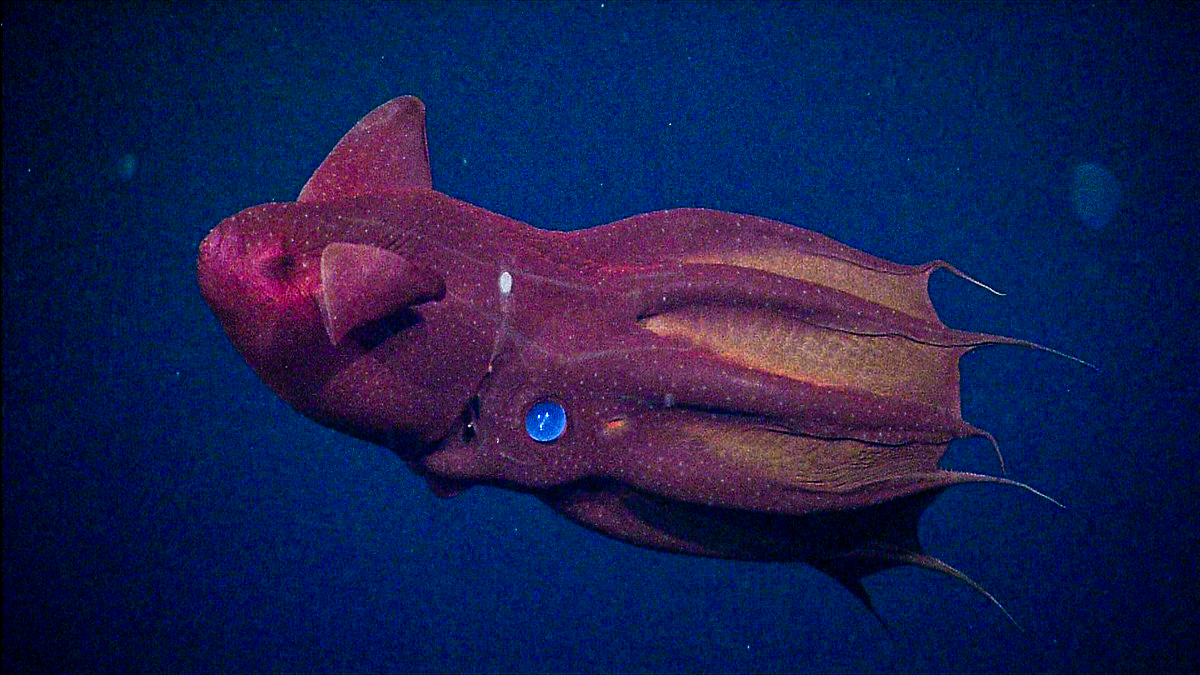Vampire Squid: Unique Deep-Sea Cephalopod Adapted to Extreme Ocean Environments
The vampire squid (Vampyroteuthis infernalis), whose name translates to "vampire squid from hell," is a deep-sea cephalopod that has intrigued scientists and ocean enthusiasts alike. Despite its ominous name and appearance, this creature is a gentle denizen of the ocean's depths, exhibiting unique adaptations that enable its survival in extreme environments.

Taxonomy and Evolutionary Significance
The vampire squid occupies a unique position in the cephalopod lineage. It is the sole extant member of the order Vampyromorphida, representing a phylogenetic relict with characteristics of both octopuses and squids. This distinct classification underscores its evolutionary significance and offers insights into the ancestral traits of cephalopods.
Physical Description
Adult vampire squids typically reach a length of about 30 centimeters (12 inches). Their gelatinous bodies are dark red to black, complemented by large blue eyes—proportionally the largest in the animal kingdom. A notable feature is the webbing, or "cape," that connects their eight arms, each lined with fleshy spines called cirri. Unlike true squids, they lack traditional ink sacs.
Habitat and Distribution
Vampire squids inhabit the mesopelagic to bathypelagic zones of temperate and tropical oceans worldwide, thriving at depths ranging from 600 to 3,000 meters (2,000 to 9,800 feet). They are specially adapted to oxygen minimum zones (OMZs), where oxygen saturation can be as low as 3%.
Adaptations to Deep-Sea Life
Oxygen Utilization: Vampire squids possess hemocyanin-rich blood, enhancing oxygen transport efficiency in hypoxic conditions. Their low metabolic rate further reduces oxygen requirements, enabling survival in OMZs.
Buoyancy: Their gelatinous tissues, with densities closely matching seawater, confer neutral buoyancy, allowing energy-efficient navigation through the water column.
Sensory Adaptations: Large eyes and well-developed optic lobes enhance sensitivity to faint bioluminescent cues, facilitating prey detection and predator avoidance in the deep-sea's perpetual darkness.
Feeding Behavior
Contrary to what its name might suggest, the vampire squid is not a predator. It employs two retractile filaments to capture marine snow—organic detritus descending from upper ocean layers. These filaments, longer than the squid's body, are equipped with mucus-covered suckers that trap particles, which are then transferred to the mouth. This detritivorous diet is well-suited to the nutrient-scarce deep-sea environment.
Defense Mechanisms
When threatened, the vampire squid exhibits a defensive posture known as "pineapple posture," inverting its cape to conceal its head and display spiny cirri, making it appear larger and more intimidating. Lacking ink sacs, it ejects a bioluminescent mucus containing light-producing particles to disorient predators, providing an opportunity to escape.
Reproductive Strategy
The reproductive habits of vampire squids are unique among cephalopods. Females can store spermatophores (sperm packets) for extended periods before fertilizing their eggs, allowing for flexible timing in reproduction. Notably, females do not die after a single reproductive event, suggesting a multiple spawning strategy that contrasts with the semelparity observed in many other cephalopods.
Lifespan
Vampire squids are believed to have a lifespan of up to 10 years, which is relatively long compared to other cephalopods. This extended lifespan is likely an adaptation to the low-energy, resource-scarce environment of the deep sea.
Conservation Status
Currently, there are no significant threats to vampire squid populations, and they are not listed as endangered. Their deep-sea habitat offers a refuge from many human activities that impact marine life. However, ongoing changes in ocean conditions, such as deoxygenation and acidification, could potentially affect their populations in the future.
Research and Exploration
Studying vampire squids presents challenges due to their deep-sea habitat. Advancements in deep-sea exploration technologies, such as remotely operated vehicles (ROVs), have allowed scientists to observe these elusive creatures in their natural environment, providing valuable insights into their behavior, physiology, and ecology.
Cultural Impact
The vampire squid's unique appearance and name have captivated public imagination, often featuring in media and literature as a symbol of the mysterious deep sea. Its portrayal ranges from a fearsome predator to a gentle deep-sea dweller, reflecting the blend of fact and myth that surrounds many deep-sea creatures.
Conclusion
The vampire squid is a remarkable example of deep-sea adaptation, exhibiting a suite of physiological and behavioral traits that enable its survival in one of Earth's most extreme environments. Its unique evolutionary position and lifestyle continue to intrigue scientists, offering insights into the diversity and resilience of life in the deep ocean.
0 Comment to "Vampire Squid: Unique Deep-Sea Cephalopod Adapted to Extreme Ocean Environments"
Post a Comment